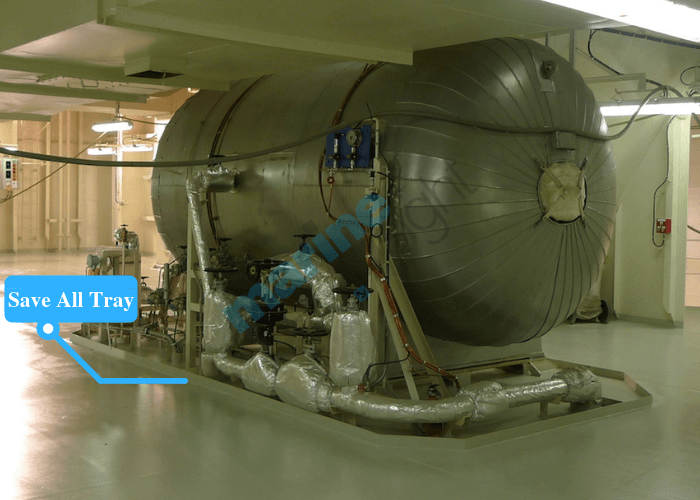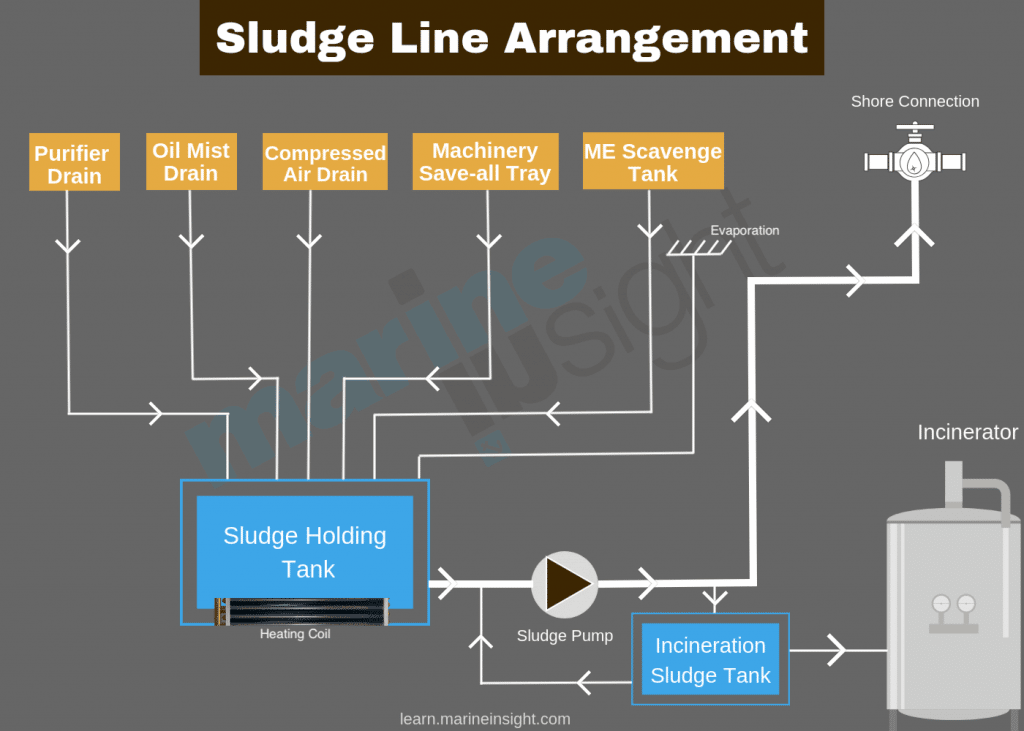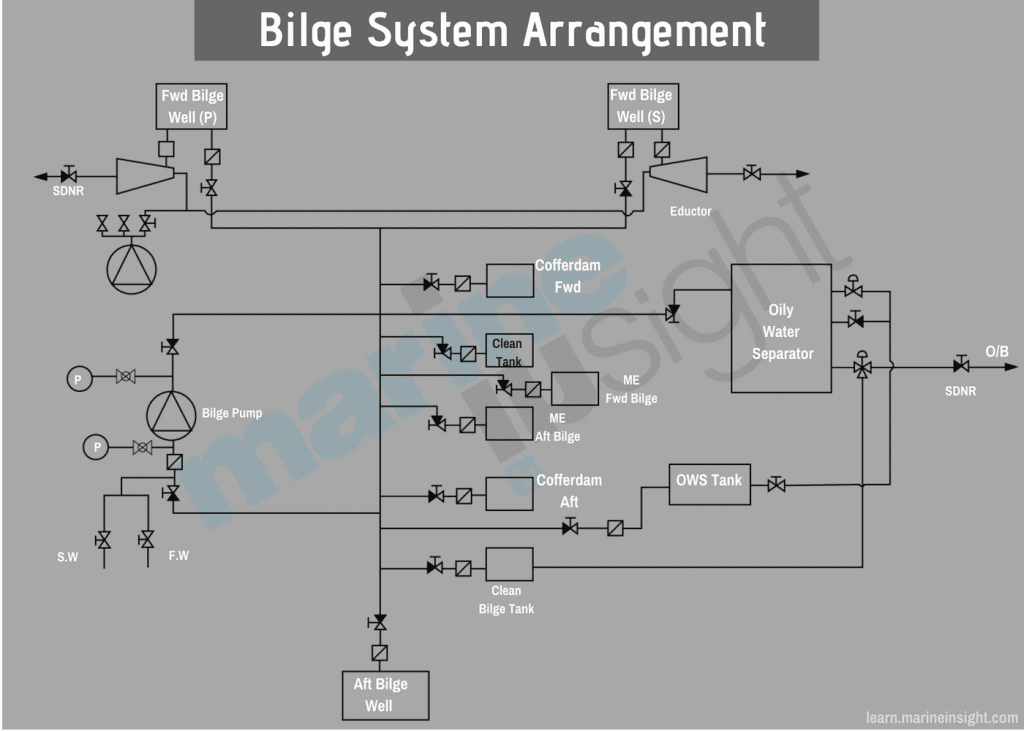An Overview Of Sludge And Bilge Management Onboard Ships
The operation of the main engine, various types of auxiliary machinery, and handling of fuel oil results into the production of sludge on board ships. This sludge is stored in various engine room tanks and is discharged to shore facility or incinerated onboard. Also, various leakages from seawater and freshwater pumps, leakages from coolers, etc. generates bilges.
In this article, we will see from where sludge and bilge are generated, how they are stored in engine room tanks, what record keeping is done, and how sludge and bilges are incinerated, evaporated, or discharged.
Sludge Production On Ship
Sludge on board ship comes from various sources like:
1. Fuel Oil Purifiers
The fuel oil purifiers have a designated discharge interval depending on the quality of fuel oil. After every set interval the bowl of the purifier discharges sludge accumulated, into the sludge tank or designated fuel oil purifier sludge tank. This sludge contains oily water and impurities which has been separated from the fuel oil by the purifiers.
2. Lube Oil Purifiers
The lube oil purifiers have a designated discharge interval depending on the quality of lube oil and the running hours of Main engine and Auxiliary generators. After every set interval the bowl of the purifier discharges sludge accumulated, into the sludge tank or designated lube oil purifier sludge tank. This sludge contains oily water and impurities which has been separated from the lube oil by the purifiers.
Related Read: 8 Ways To Optimize Lubricating Oil Usage On Ship
3. Main Engine Scavenge Drains
When the main engine is running, oil residue in scavenge spaces is collected from the cylinder lubrication being scrapped down from the liners. This oil is drained through scavenge drains of each unit of the main engine and collected into the sludge tank or designated scavenge drain tank.
Related Read: Everything You Ever Wanted to Know About Scavenge Fires
4. Main engine stuffing box
When the main engine is running, oil residue is collected from the stuffing box scraping oil on the piston rod. This oil comes from the stuffing box drains of each unit of the main engine is collected into the sludge tank or designated Stuffing Box drain tank.
5. Save all tray drains of oil machinery
All fuel oil machinery i.e. pumps, filters, purifiers, etc. have the tray under them to collect any leakage if occurs. The drain of the tray goes into sludge tanks.

6. Miscellaneous
They are other drains going into the sludge tank, for example, air bottle drains, fuel oil settling and service tank drains, etc. All these drains are oily water and are collected in sludge tanks.
Related Read: A Comprehensive List of Fuel, Diesel and Lube Oil Tanks on a Ship
Sludge Tanks
The number of sludge tanks varies from ship to ship, it depends on from which shipyard ship is built and also depends on the machinery in the engine room. Some ships have one common sludge tank and some have individual sludge tanks. Sludge pump is used to make internal transfers and transfer to shore reception facility. All sludge tanks have to be in compliance with flag state oil record book and every transfer has to be recorded in oil record book. All designated sludge tanks and bilge tanks have to be mentioned in International Oil Pollution Prevention (IOPP) certificate. Any transfer from or into IOPP tanks has to be recorded in Oil Record Book for the Engine room by the Chief Engineer.
Sludge Incineration And Oily Water Evaporation
The sludge generated have some water content in them coming from HFO & LO purifiers, from HFO settling and service tank drains, Air bottle drains. This water can be evaporated in the waste oil tank. Sludge is transferred from various sludge tanks into waste oil tank for incineration. Before incineration, all the water has to be evaporated so that sludge can be burned efficiently in the incinerator.
Related Read: Construction and Working of Waste Oil Incinerator
Sludge is transferred from HFO purifier sludge tank, LO purifier sludge tank and Oily bilge sludge tank into the Waste oil tank and steam valves (inlet and return) are kept open for water evaporation. The tank temperature reaches 100 degrees Celsius and water starts evaporating, when the temperature goes above 100 degrees Celsius it indicates that the water has been evaporated and oil has started to heat up. Now the sludge is ready for incineration. The quantity of water evaporated has to be recorded in the oil record book.

If there is a common sludge tank, then water is allowed to settle for few days in the common sludge tank at the bottom. After the water has been settled at the bottom, suction from the bottom is taken and transferred to waste oil tank for water evaporation.
Before transferring any sludge into the waste oil tank, the temperature of the waste oil tank should be less than 90 degrees Celsius to prevent boil off in the tank. Boil off will result into instant tremendous pressure rise in the tank.
After the water has been evaporated and sludge is heated up, it is ready for incineration. For incineration, follow these steps:
- Drain and check if any water from waste oil (sludge) in the tank before burning.
- Agitate the sludge in waste oil tank if an agitator is present. This will help in emulsifying the oil into an even mixture for fine atomization.
- Warm up the incinerator with diesel oil. Incinerator should be operated by a qualified person with all necessary safety precautions.
- After warming up, open the feed valve for waste oil from the waste oil tank. Ensure steam tracing is proper for the waste oil line and strainers are not chocked. Adjust the damper and temperature according to the manual.
- The waste oil pump will take suction from the waste oil tank. Continue burning waste oil and maintain incinerator parameters. Depending on the capacity of the waste oil pump, compare and check how much waste oil is burning in the incinerator. The final amount of sludge incinerated has to be recorded in an oil record book.
The amount of sludge generated on board is with the proportion of the fuel consumption. In general, average sludge production is considered to be 1.5% of total fuel consumption. If the sludge generation is more than 1.5%, sludge production of the ship is high.
Engine Room Bilge Water Generation
Leakages from fresh water and sea water pumps, coolers are collected in bilge wells in the engine room. Bilge wells are located at the forwarding of the bottom platform at the tank top port and starboard. Other bilge wells are at the aft of engine room, recess bilge well under the flywheel, shaft tunnel bilge well if separate space for shaft tunnel is present.
All the leakages in the engine room bottom platform are collected in these bilge wells and can be transferred to the bilge holding tank via the oily bilge pump. The oily bilge pump may also pump these spaces to the sludge tank (via the sludge pump bypass line) and the deck connections for discharge to shore or barge.
Related Read: Good Bilge Management Practices
The oily bilge pump transfers bilges to bilge holding tank via bilge primary tank. Bilge primary tank is of smaller capacity present to separate oil from bilges. Bilge primary tank is overflowed to bilge holding tank. Any oil layer formed on top of the bilge primary tank can be removed.
The bilge tanks in the engine room are:
Bilge Holding Tank
Bilges from bilge well are transferred here and stored to be discharged overboard via oily water separator and PPM monitor or to be discharged ashore.
Bilge Primary Tank
Bilge is transferred here to separate oil by gravity. Any oil layer formed on the top can be removed
Bilge Evaporation Tank
Present on some ships in which bilge can be transferred and evaporated by heating.
Air cooler drain tank
All the moisture from Main Engine scavenge air coolers and generator scavenge air cooler is drained in this tank. They might have some oil as engine room air may contain oil vapour. Hence they are discharged overboard via PPM monitor.

Atmospheric air contains moisture and when this air is compressed in the turbocharger and then cooled in the air cooler, the moisture condenses to form water droplets. If these water droplets enter the cylinders with the scavenge air they can remove the oil film from the liner, resulting in excessive cylinder liner and piston ring wear.
Additionally, removal of water droplets from the air minimises the risk of sulphuric acid formation in the cylinders and uptakes due to the dissolving of acid products of combustion in the water droplets. In order to prevent these problems, water is removed from the combustion air by water separators fitted after the scavenge air coolers. The water droplets are directed from the air coolers, via drain traps, to the air cooler drain tank.
Related Read: Understanding Hot And Cold Corrosion In Marine Engines
This tank is pumped overboard by the air cooler drain discharge pump or bilge pump, the discharge from this pump overboard. The water flowing to the overboard discharge line passes through an oil detector, which monitors the oil content of the water being discharged overboard. It is also possible to pump the contents of the air cooler drain tank to the bilge holding tank using the oily bilge pump.
All the bilge transfers, bilge discharge overboard or to shore, bilge evaporation has to be recorded in oil record book. Whenever Oily water separator is operated, the position of the vessel at starting and stopping has to be recorded along with time and volume of bilge discharge. The PPM monitor will not allow discharge of bilge having more than 15ppm of oil content.
Related Read: How to Operate an Oily Water Separator (OWS) on Ship?
Cargo Hold Bildge Water Production
Cargo holds, generally of container vessels, have bilge wells located at the bottom on each side, port, and starboard. The hold bilges are normally pumped overboard through bilge eductor from Fire & GS pump as they contain only water. However, before pumping hold bilge wells, a visual inspection has to be carried out of the bilge wells. If any traces of oil is found, then they have to be pumped to the hold bilge collecting tank or other designated engine room tank, from where they would be processed in the OWS. Before any bilges are pumped directly overboard, it must be ensured that no local or international anti-pollution regulations will be contravened. The eductor should only be used when at sea.
The hold bilge line additionally takes suction from bow thruster room bilge wells, pipe duct bilge wells, chain locker bilge well, and forepeak void space. All the bilge wells valves can be operated remotely from the ship’s office or engine control room.
Sludge and bilge management on-board are very critical and important. MARPOL rules are very stringent and have to be followed properly to prevent pollution at sea. Any violation of MARPOL can lead to imprisonment and huge fines.
Disclaimer :
The information contained in this website is for general information purposes only. While we endeavour to keep the information up to date and correct, we make no representations or warranties of any kind, express or implied, about the completeness, accuracy, reliability, suitability or availability with respect to the website or the information, products, services, or related graphics contained on the website for any purpose. Any reliance you place on such information is therefore strictly at your own risk.
In no event will we be liable for any loss or damage including without limitation, indirect or consequential loss or damage, or any loss or damage whatsoever arising from loss of data or profits arising out of, or in connection with, the use of this website.
Disclaimer :
The information contained in this website is for general information purposes only. While we endeavour to keep the information up to date and correct, we make no representations or warranties of any kind, express or implied, about the completeness, accuracy, reliability, suitability or availability with respect to the website or the information, products, services, or related graphics contained on the website for any purpose. Any reliance you place on such information is therefore strictly at your own risk.
Related Articles
Do you have info to share with us ? Suggest a correction
Subscribe To Our Daily Newsletter
By subscribing, you agree to our Privacy Policy and may receive occasional deal communications; you can unsubscribe anytime.











Thanks youre information
@Jual ?
Hi, can anybody answer pls, is there any regulation under marpol or solas which prohibits engine room bilge transfer to deck slop tank?
thanks
very interesting and informative article. Do you have any typical figures for the quantity of oily sludge generated on a typical ship each day?
Hi Maek
Thank you for your comment. The quantity will depend on several factors, such as size of the ship, condition of machinery etc.
Main engine recess bilge alarm. What are the sources of bilge to this recess bilge well? What are to be checked when this alarm comes?
Main engine recess bilge well high level alram. Actions to be taken???
effective post sir,thanks.
@Masum: Glad you liked it
Very informative post! Does anyone know the code waste from the European Waste Catalog (EWC) for the sludge?
Very informative post! Does anyone know the waste code of the sludge from the European Waste Catalogue (EWC)?
The European Waste Catalogue (EWC) code for sludge is 18.04